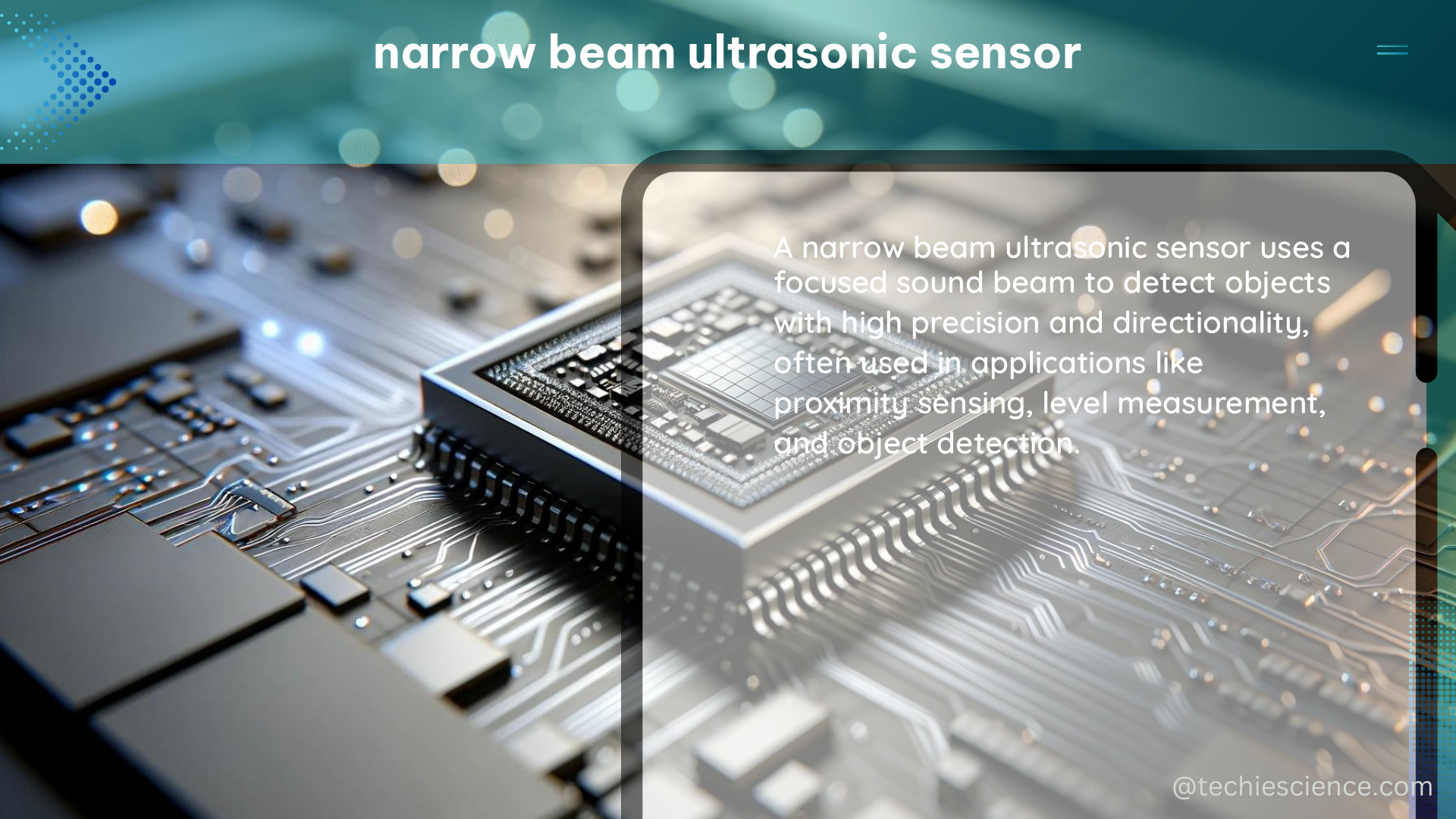Narrow beam ultrasonic sensors are specialized devices that emit and receive ultrasonic waves in a highly focused beam pattern, enabling them to perform accurate distance measurements in specific directions. These sensors are particularly useful in applications where a wider beam angle may result in inaccurate readings due to reflections from nearby objects.
Understanding the Fundamentals of Narrow Beam Ultrasonic Sensors
Narrow beam ultrasonic sensors differ from standard ultrasonic sensors in several key ways:
-
Beam Angle: Narrow beam ultrasonic sensors typically have a much narrower beam angle compared to their standard counterparts. For example, the MaxBotix-UT Ultrasonic Transducer has a beamwidth of around 30 degrees, while the TFMini sensor has an exceptionally narrow field of view (FoV) of only 2.3 degrees.
-
Measurement Range: Narrow beam ultrasonic sensors often have a longer measurement range than standard ultrasonic sensors. The TFMini, for instance, can take measurements up to 12 meters, making it suitable for applications that require long-distance detection.
-
Directionality: The narrow beam pattern of these sensors allows for more precise directional control and targeting of specific objects or areas, reducing the impact of interference from nearby objects.
Achieving Narrow Beam Ultrasonic Sensing

There are several approaches to creating narrow beam ultrasonic sensors, both commercially and through DIY methods:
Commercial Narrow Beam Ultrasonic Sensors
-
MaxBotix-UT Ultrasonic Transducer: This transducer has a beamwidth of around 30 degrees, which can be further narrowed by using an array of these transducers in close proximity and driving them in phase.
-
TFMini Ultrasonic Sensor: With its exceptionally narrow FoV of 2.3 degrees, the TFMini is a prime example of a commercially available narrow beam ultrasonic sensor. It also features a single trigger mode for more control and reduced power consumption.
DIY Narrow Beam Ultrasonic Sensors
-
Phased-Array Sonar System: By using an array of standard ultrasonic transducers and driving them in phase, it is possible to achieve a narrower effective beamwidth. For instance, an array of four transducers spaced 16.4mm apart can result in a beamwidth of approximately 6 degrees.
-
Acoustic Lens Modification: Another DIY approach is to modify an existing ultrasonic sensor by adding an acoustic lens, which focuses the ultrasonic waves in a narrower beam pattern. However, this method may not be practical for air-based applications due to the relatively large wavelength of ultrasonic waves in air.
Technical Specifications and Considerations
When working with narrow beam ultrasonic sensors, it’s essential to understand the technical specifications and how they impact the sensor’s performance:
| Specification | Example Values |
|---|---|
| Beam Angle | 2.3 degrees (TFMini), 30 degrees (MaxBotix-UT) |
| Measurement Range | Up to 12 meters (TFMini) |
| Trigger Mode | Single trigger mode (TFMini) |
| Power Consumption | Reduced power consumption with single trigger mode |
Additionally, it’s important to consider the trade-offs between beam angle, measurement range, and response time when selecting a narrow beam ultrasonic sensor for a specific application. A narrower beam angle may provide more accurate distance measurements, but it may also make it more difficult to detect objects outside the sensor’s field of view. Conversely, a wider beam angle may be more suitable for detecting objects in a larger area, but the accuracy of distance measurements may be compromised.
Practical Applications of Narrow Beam Ultrasonic Sensors
Narrow beam ultrasonic sensors find applications in a variety of industries and scenarios, including:
-
Robotics and Automation: Precise distance measurements and object detection in robotic systems, such as automated guided vehicles (AGVs) and industrial robots.
-
Security and Surveillance: Targeted monitoring and intrusion detection in specific areas, reducing the impact of false alarms from nearby objects.
-
Automotive Systems: Advanced driver-assistance systems (ADAS) that require accurate distance measurements to nearby vehicles and obstacles.
-
Industrial Automation: Precise level monitoring and object detection in manufacturing and processing environments.
-
Architectural and Construction: Accurate measurement and mapping of building interiors and structures.
By understanding the technical specifications, capabilities, and limitations of narrow beam ultrasonic sensors, engineers and DIY enthusiasts can make informed decisions and develop innovative solutions that leverage the unique advantages of these specialized devices.
Conclusion
Narrow beam ultrasonic sensors are a powerful tool for applications that require accurate distance measurements and targeted object detection. By exploring both commercial and DIY approaches, you can unlock the full potential of these sensors and create innovative solutions that address the specific challenges in your field. Remember to carefully consider the trade-offs between beam angle, measurement range, and response time to ensure the best fit for your application.
References
- Narrowing the beam of an ultrasonic sensor. : r/AskEngineers – Reddit
- Narrowing the beam of an ultrasonic sensor – Electronics Stack Exchange
- Long Range Narrow Beam Ultrasonic Sensor – Arduino Forum
- Debunking Myths Surrounding Ultrasonic Sensor Reliability – AZoSensors
- Ultrasonic sensor with very narrow beam – Arduino Forum

The lambdageeks.com Core SME Team is a group of experienced subject matter experts from diverse scientific and technical fields including Physics, Chemistry, Technology,Electronics & Electrical Engineering, Automotive, Mechanical Engineering. Our team collaborates to create high-quality, well-researched articles on a wide range of science and technology topics for the lambdageeks.com website.
All Our Senior SME are having more than 7 Years of experience in the respective fields . They are either Working Industry Professionals or assocaited With different Universities. Refer Our Authors Page to get to know About our Core SMEs.